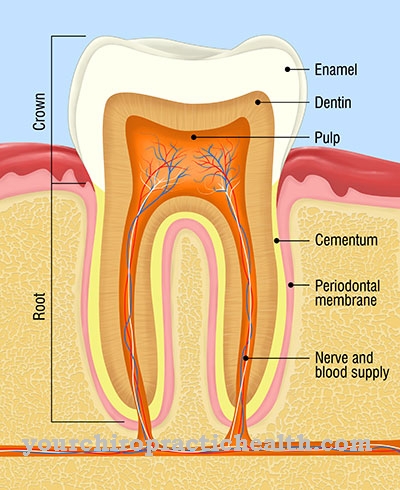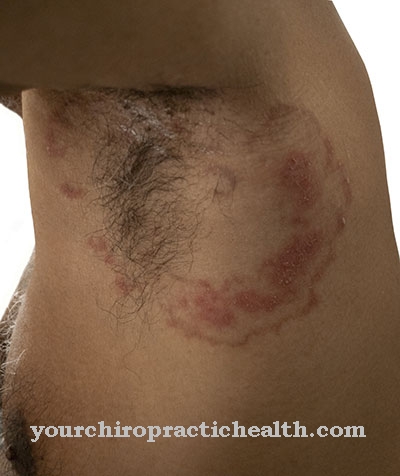As a life-saving measure, an amputation is often the last resort. After that it happens relatively often Amputation pain. There are two types: phantom pain and stump pain.
What is amputation pain?

After the surgical removal of a part of the body, one speaks of an amputation. The consequence of this life-saving surgical procedure is often amputation pain. A distinction is made between phantom pain and stump pain.
Doctors are still puzzling over the cause of phantom pain. The part of the body that is actually no longer there is painful, although it no longer belongs to the body. Phantom pain is the result in more than 50 percent of all amputations. Even if a limb is amputated in an accident, this amputation pain can occur.
Some sufferers also have symptoms of touch, temperature and movement in the amputated limb. One then speaks of phantom sensations.
Another type of amputation pain is stump pain. Here the pain occurs directly on the amputation stump. There is chronic and acute stump pain.
causes
The causes of amputation pain are different. Depending on how the pain occurs, one speaks of phantom pain and stump pain. Amputation pain in the absent limb is called phantom pain.
The reasons for this have not yet been researched. There are various theories as to how this pain occurs. The severity of the amputation pain mainly depends on how long the pain lasts before the amputation and how intense it was. The irritated nerve cells have stored the pain and continue to react later, even if there is no longer any stimulus.
Reduced blood flow in the remaining residual limb or increased muscle tension are also possible. Psychological factors are also conceivable. The amputation pain can vary in intensity depending on the patient's condition.
Stump pain often occurs immediately after the amputation. These acute amputation pains are a result of wound pain, infection, and bruising. If the residual limb pain is chronic, the causes are, for example, circulatory disorders, nerve damage, bone spurs, scar pain, Sudeck's disease, poor prosthesis fitting and chronic infections.
You can find your medication here
➔ Medicines for painSymptoms, ailments & signs
First and foremost, amputation pain is associated with very severe pain. These occur mainly in the affected region, where a limb is being amputated. In most cases, no direct prediction can be made about the course of the amputation pain.
In the worst case, these can occur over several months and not go away on their own. The pain itself often spreads to the neighboring regions of the body, so that severe pain also occurs in these areas. Especially at night, the amputation pain can lead to insomnia and thus to irritability or depression.
In general, too, permanent pain can lead to psychological upsets and make everyday life much more difficult for the person concerned. Often this pain can only be limited and relieved to a certain extent by taking pain. In addition to the amputation pain, infection or inflammation of the wound can also occur.
This is often associated with a discharge of pus or with a reddening. The pain also usually increases when the affected area is strained or stressed. In general, the patient's resilience drops significantly.
Diagnosis & course
First, the doctor tries to find out whether the amputation pain occurs on the non-existent part of the body or on the stump. The person concerned must describe the pain very precisely. It is important to state the duration, intensity, character and triggering factors and whether countermeasures have already been taken.
A pain diary can be very helpful for documentation. Even if phantom pain is suspected, all causes of residual limb pain must be ruled out. During a physical examination, the doctor examines the surgical stump and tries to find out whether there is any inflammation, hardening, pain points or circulatory disorders. Magnetic resonance imaging, x-rays, and angiographies can be performed for further diagnosis.
The course of amputation pain depends on the cause and the type of pain. Stump pain can be acute or chronic. They often arise right after the amputation. Phantom pain, on the other hand, is more protracted, can improve on its own and come back suddenly after a while. For all types of amputation pain, early therapy is important for long-term success.
Complications
Amputation pain always occurs after an amputation and is, to a certain extent, completely normal. The affected person has to take pain relievers for the pain, but these should go away on their own a few weeks after the amputation. However, it is also possible that the amputation pain persists months after the amputation.
If this pain is still very strong, you should definitely consult a doctor. Amputation pain often occurs because the wound has an infection or inflammation. Such infections or inflammations must urgently be treated by a doctor. This can lead to serious health problems if these infections are not removed in time.
A pain diary is a huge help for the doctor in determining the cause of the pain. The amputation pain also arises when the limb that has been amputated is relatively heavily used. Especially in the first months after the amputation, the affected limb must be spared and must not be physically strained. The amputation pain occurs when it is used and is completely normal. However, they will go away when the wound has completely healed.
When should you go to the doctor?
Amputation pain is one of the most severe and complex pains in the human body. They occur immediately after amputation of a part of the body or an internal organ and are then normal and to be expected. While the patient is still in the hospital, he should talk to the attending physician about the pain, if the pain medication administered so far does not at least make it bearable.
Surgical pain usually improves within a few days or weeks, so it becomes weaker and easier to bear. If this is not the case, the doctor should re-examine the surgical wounds and find out why the pain is still so severe. In the case of amputation pain, however, a psychological component is added even months and years after the first surgical pain. The affected person can feel pain as if the removed body part was still there. The stump can also cause severe pain when limbs are removed.
Poorly fitting prostheses create pressure points and scraped skin, which are also counted as amputation pain. In all these cases, the patient should consult the doctor as soon as possible, because at the latest when psychologically induced amputation pain occurs, it can be assumed that these can no longer be managed without medical help. There is a risk that the patient will take uncontrollably strong painkillers and become addicted to them after a short period of use.
Doctors & therapists in your area
Treatment & Therapy
The therapy depends on whether the amputation pain is phantom pain or stump pain.
In the case of phantom pain, the pain is primarily combated because the cause of the pain is no longer present. The therapy for this amputation pain must be carried out quickly and consistently. If the pain continues for more than six months, it is difficult to treat.
Medicines such as opiates, pain relievers, psychotropic drugs, calcitonin and capsaicin are suitable. Phantom pain is also treated with neural therapy, mirror therapy or psychotherapy.
Stump pain is treated by removing the cause. Infections have to be cured and ill-fitting prostheses have to be better adapted. In the meantime, benign knot formations and undirected new nerve formations are no longer removed.
Outlook & forecast
In most cases, amputation pain is a common symptom that usually cannot be avoided. This pain subsides over time, although no general course can be predicted. In some cases, people may experience pain months after the amputation.
Furthermore, the amputation pain can also be caused by an infection or an inflammation, so that it must be treated in any case. Treatment is then carried out with the help of antibiotics, which usually lead to a positive course of the disease. Painkillers are also used to limit amputation pain and make everyday life easier for those affected.
The quality of life is significantly reduced by the pain and it is not uncommon for psychological complaints or depression to occur. Psychological treatment of the patient may be necessary to prevent further consequential damage. Most amputation pain can also be reduced by fitting prostheses. This pain cannot be limited in every case. Amputation may also reduce the patient's life expectancy.
You can find your medication here
➔ Medicines for painprevention
Amputation pain can only be prevented to a limited extent. The best prevention is to give pain medication before the amputation. The nerves can no longer “remember” the pain before the surgical procedure.
Electrical stimulation methods help to prevent amputation pain immediately after the amputation if they are applied directly to the stump. It is also very important that the prosthesis fits very well and that this is checked regularly and readjusted if necessary.
Aftercare
Two different types of pain are known to occur after a limb is amputated. Both must be treated as soon as possible. Amputation pain can be very real pain on the remaining arm or leg stump. This pain can be caused by pressure points on the stump or. It can also be pain from wound infections.
Follow-up care should not end until the stump has healed. It also includes fitting a prosthesis and practicing with it. But even later, problems with amputation pain can always arise. In some cases, renewed follow-up is necessary because a severe inflammation or pressure point in a diabetic needs treatment.
Sometimes aftercare requires further shortening of the amputation stump by a few centimeters. The prosthesis must then also be adjusted during the follow-up. The so-called phantom pain also belong to the typical amputation pain. It is about attacks of pain in the limb that is no longer present.
Because these amputation pains don't always appear immediately after amputation and have no real location, they are harder to treat. Follow-up care can only include pain relief and education about the nature of this pain phenomenon. Follow-up care should begin as soon as possible after the amputation, because then amputation pain is easier to resolve.
You can do that yourself
In the case of amputation pain, a distinction must be made between stump pain and phantom pain when it comes to measures that the person affected can take to alleviate them.
Strictly speaking, since phantom pain has no physical cause, the brain must also be acted upon in cases of non-drug therapy. It has been shown that the so-called mirror therapy, in which the presence of two healthy limbs is simulated using an appropriate and handy device, brings relief. The brain is tricked into moving and relaxing the healthy part of the body in such a way that the reflection - that is, the representation of the amputated body part - has to come into the same position. The brain interprets this as actual relaxation.
Phantom pain such as stump pain can also be alleviated by means of electrical stimulation. Massages of the limbs and certain gymnastics exercises can also help.
In the case of residual limb pain, the effectiveness of any measures taken depends very much on the cause of the pain. Incorrectly fitting prostheses and infections cannot be dealt with alone. Sudden relapses of pain without an apparent cause can usually be relieved with medication rather than with massages or warm baths.
In the case of painful conditions, relaxation measures are generally positive. This can include engaging in a hobby, going to the sauna, or taking a short rest in bed. Consuming herbal substances that have an analgesic effect can also be part of pain therapy.



.jpg)
.jpg)








.jpg)

.jpg)
.jpg)











.jpg)